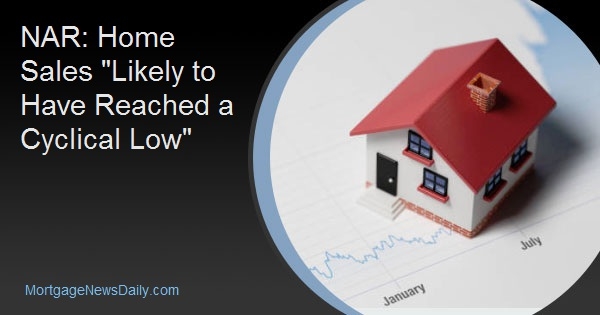Existing home sales fell again in January although the decline was a minor one compared to the 6.4 percent drop in December. The National Association of Realtors® (NAR) said sales of single-family homes, townhomes, condominiums and co-ops ticked down 1.2 percent from December's annual rate of 4.99 million to a seasonally adjusted annual rate of 4.94 million. That number, the lowest since November 2015, put sales behind those a year earlier (5.40 million) by 8.5 percent.
Single-family home sales declined from 4.45 million in December to 4.37 million, putting them 8.4 percent lower on a year-over-year basis. Existing condominiums and co-ops sold at an annual rate of 570,000 units in January, up 3.6 percent from last month and down 9.5 percent from a year ago.
Analysts, pointing to lower mortgage rates and "an easy comparison against a very weak December" had expected at least a slight increase in January sales. Those polled by Econoday had forecasted in a range of 4.90 to 5.20 million, with a consensus of 5.04 million.
Lawrence Yun, NAR's chief economist, acknowledged the sluggish sales, but said he does not expect the numbers to decline further going forward. "Existing home sales in January were weak compared to historical norms; however, they are likely to have reached a cyclical low. Moderating home prices combined with gains in household income will boost housing affordability, bringing more buyers to the market in the coming months."
The median existing-home price for all housing types in January was $247,500, up 2.8 percent from the January 2018 median of $240,800. January's price increase marks the 83rd straight month of year-over-year gains.
The median existing single-family home price rose 3.1 percent on an annual basis to $249,400. The median existing condo price was $233,000, an 0.1 percent annual gain.
Yun notes that this median home price growth is the slowest since February 2012 and cautions that the figures do not yet tell the full story for the month of January. "Lower mortgage rates from December 2018 had little impact on January sales, however, the lower rates will inevitably lead to more home sales."
The inventory of existing homes for sale at the end of January was 1.59 million, up from 1.53 million in December and 1.52 million a year ago. Unsold inventory is at a 3.9-month supply at the current sales pace, up from 3.7 months and 3.4 months respectively during the two earlier periods.
Properties remained on the market for an average of 49 days in January, up from 46 days in December and 42 days a year ago. Thirty-eight percent of homes sold in January were on the market for less than a month.
While it was the sixth straight month that the total inventory grew on a year-over-year basis, Yun says the market is still suffering from too few homes for sale. "In particular, the lower end of the market is experiencing a greater shortage, and more home construction is needed," says Yun. "Taking steps to lower construction costs would be a tremendous help. Local zoning ordinances should also be reformed, while the housing permitting process must be expedited; these simple acts would immediately increase homeownership opportunities and boost local economies."
"Decelerated sales and the increases in inventory will work in favor of potential homebuyers, putting them in a better negotiating position heading into the spring months," said NAR President John Smaby, "On top of that, low-interest rates will bring an additional $80 per month savings compared to the rates of just a few months ago."
First-time buyers were responsible for 29 percent of sales in January, down from last month (32 percent), but the same as a year ago. Investors purchased 16 percent of homes sold during the month, down from 17 percent in January 2018. Twenty-three percent of sales were all cash, up from 22 percent in both December and in January 2018.
Distressed sales - foreclosures and short sales - increased for the first time in many months. They represented 4 percent of sales in January, up from 2 percent last month and down from 5 percent a year ago.
The Northeast was the only region in which existing home sales increased during the month. They rose 2.9 percent month-over-month to an annual rate of 700,000. This was still down 1.4 percent on an annual basis. The median price of a home sold during the month gained 0.4 percent to $270,000
In the Midwest, existing-home sales fell 2.5 percent to an annual rate of 1.16 million in January and were down 7.9 percent from a year ago. The median price in the Midwest was $189,700, an annual increase of 1.4 percent.
Existing-home sales in the South dropped 1.0 percent to an annual rate of 2.08 million in January, down 8.4 percent from last year. The median price was $214,800, up 2.5 percent from a year ago.
The West saw a 2.9 percent downturn in sales to an annual rate of 1.00 million, a rate 13.8 percent below a year ago. The median price in the West increased by 2.9 percent to $374,600.







